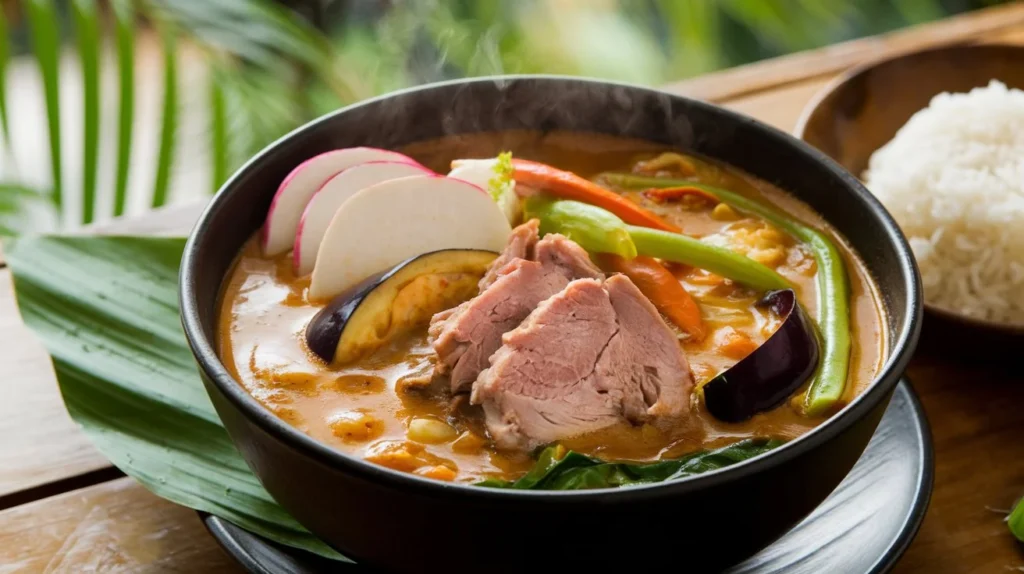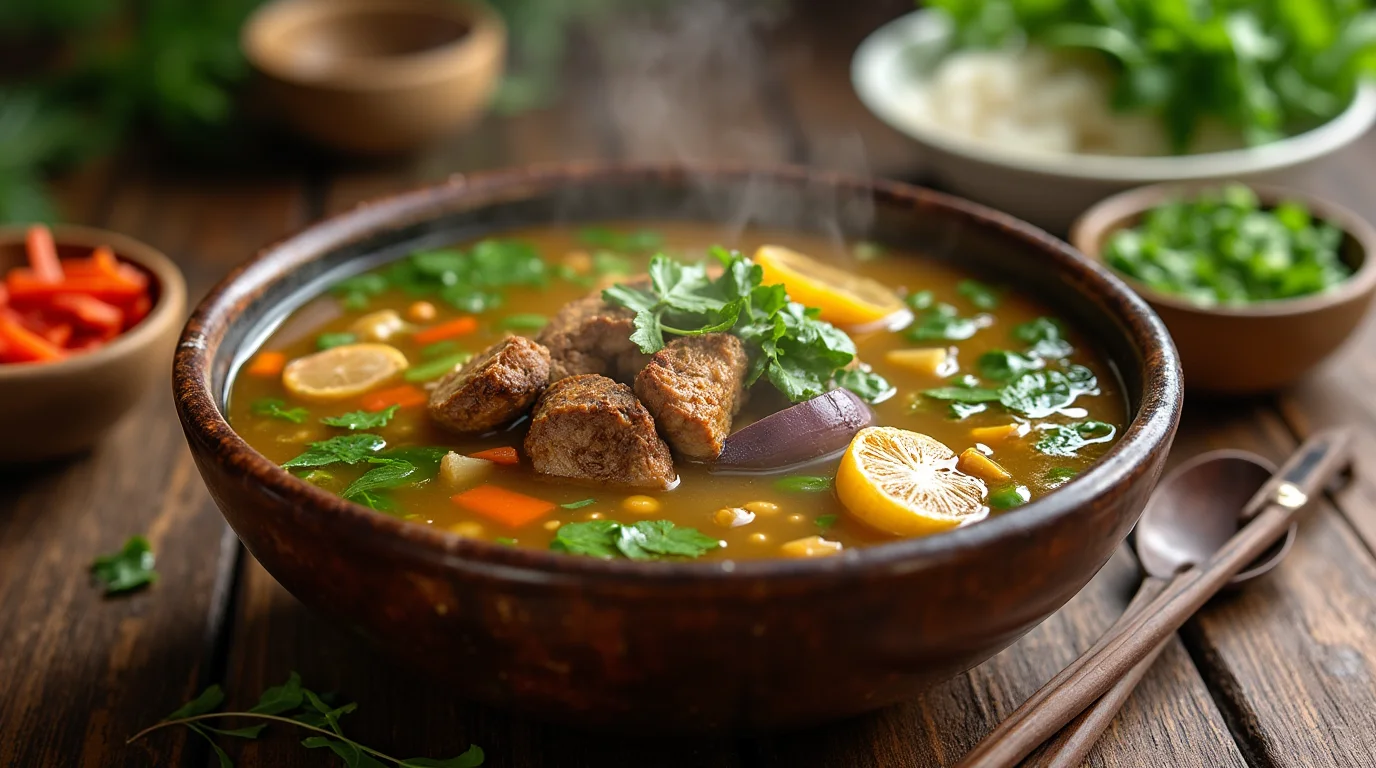Table of Contents

Get ready to explore the world of Filipino cuisine with sinigang. This sour soup is a favorite that shows the heart of traditional cooking. It offers a mix of flavors that will take you to the Philippines.
Picture a steaming bowl of Filipino sour soup. It’s full of tender meat and fresh veggies. Sinigang is more than just a meal. It’s a cultural experience that celebrates the Philippines’ rich culinary traditions.
Whether you’re an experienced cook or just starting out, this sinigang recipe is a true taste of Filipino comfort food. It will fill your heart with warmth and thrill your taste buds.
Key Takeaways
- Sinigang is a traditional Filipino sour soup with complex flavor profiles
- The dish combines meat, vegetables, and a signature tangy broth
- Perfect for home cooks looking to explore international cuisines
- Adaptable recipe with multiple protein and vegetable options
- Represents the depth and creativity of Filipino culinary traditions
Understanding the Rich Heritage of Filipino Sinigang
Filipino cuisine is filled with traditions, and sinigang is a big part of it. This sour soup has been loved for generations. It tells a story of flavor, innovation, and community.

The history of sinigang goes back to before the Philippines was colonized. It was made with local ingredients and cooking methods. Exploring this dish opens a window into Filipino culture.
Tracing the Cultural Roots
Sinigang is more than a soup. It shows the Filipino values of adaptability and resourcefulness. It was made with what was available, creating tasty meals.
“Sinigang is not just food; it’s a reflection of Filipino resilience and creativity” – Filipino Food Historian
Regional Variations Across the Philippines
Each region in the Philippines adds its unique twist to sinigang. This shows the country’s rich culinary traditions.
| Region | Unique Sinigang Characteristic |
|---|---|
| Luzon | Heavier beef-based versions |
| Visayas | More seafood-focused recipes |
| Mindanao | Spicier interpretations with local herbs |
- Northern regions prefer tamarind-based sourness
- Coastal areas emphasize fresh seafood variations
- Mountain provinces use more root vegetables
Learning about these regional differences lets you see sinigang as more than a recipe. It’s a journey through Philippine culture.
Essential Ingredients for Authentic Sinigang

Making authentic sinigang needs the right ingredients. These ingredients mix to give the dish its tangy taste. The dish’s heart is its sour and savory balance.
The tamarind broth is key to sinigang’s sour taste. Use fresh, quality ingredients to get the true taste of this traditional dish.
Key Sinigang Ingredients
- Protein options:
- Chicken
- Fish
- Shrimp
- Vegetables:
- Kangkong (water spinach)
- Okra
- Eggplant
- Radish
- String beans
Your tamarind broth turns these ingredients into a magical dish. Choose the freshest produce. Know how each part adds to the flavor.
“Sinigang is more than just a dish; it’s a tribute to the artistry of Filipino cuisine.” – Filipino Food Historian
| Ingredient Category | Primary Function | Flavor Contribution |
|---|---|---|
| Tamarind | Souring Agent | Tangy, Acidic Base |
| Protein | Main Substance | Savory Depth |
| Vegetables | Nutritional Balance | Textural Variety |
The magic of sinigang is in its mix of ingredients. Each part is key to a perfect bowl of comfort and flavor.
The Perfect Sinigang Recipe for Beginners
Cooking sinigang sa sampalok might seem tough, but it’s easy with the right guide. This recipe makes it simple, helping you make a tasty, true Filipino dish.
First, get all your ingredients ready and set up your kitchen. A great sinigang needs organization and focus.
Basic Preparation Steps
- Pick fresh ingredients for your sinigang sa sampalok
- Wash and chop veggies into the same size
- Cut meat into small pieces
- Make your tamarind base
Tips for Achieving the Right Sourness
The secret to great sinigang is finding the right sourness. Tamarind is the traditional souring agent. You can tweak its sourness to your liking.
- Begin with a little tamarind and add more as needed
- Check the broth’s sourness often while cooking
- Choose fresh tamarind or powdered mix for a steady flavor
Cooking Time Guidelines
| Protein Type | Cooking Time | Recommended Heat |
|---|---|---|
| Beef | 45-60 minutes | Medium-low |
| Fish | 15-20 minutes | Low |
| Shrimp | 8-10 minutes | Low |
“Patience is the secret ingredient in any great sinigang recipe.” – Filipino Cooking Wisdom
Getting better at making sinigang sa sampalok takes practice. Don’t worry if it’s not perfect the first time. With each try, you’ll get better and more confident.
Mastering the Tamarind Broth Base
Making the perfect tamarind broth is key to a tasty sinigang sa sampalok. This Filipino soup’s tangy flavor comes from rich tamarind tastes. These flavors make it special.
When making your tamarind broth, you can choose from a few ways:
- Fresh tamarind pods
- Tamarind paste
- Packaged sinigang mix
- Concentrated tamarind powder
Each way gives your sinigang a unique taste. Fresh tamarind gives the best flavor. But, mixes are great for those who are short on time.
“The secret to an exceptional tamarind broth lies in balancing sourness with depth of flavor.”
To get the right tamarind broth, follow these tips:
- Strain tamarind pulp to remove seeds and fibrous parts
- Adjust water quantity for desired tanginess
- Taste and modify seasoning gradually
| Tamarind Source | Flavor Intensity | Preparation Time |
|---|---|---|
| Fresh Tamarind Pods | High | 30-45 minutes |
| Tamarind Paste | Medium | 10-15 minutes |
| Sinigang Mix | Consistent | 5 minutes |
Pro tip: Start with less tamarind and gradually increase to control the sourness of your sinigang sa sampalok.
Different Meat Options for Your Sinigang
Sinigang is a versatile Filipino soup that welcomes a wide range of protein options. Whether you prefer meat, seafood, or plant-based ingredients, you can create a delicious version of this classic dish that suits your taste and dietary preferences.
Exploring different protein choices allows you to transform the traditional sinigang recipe into a personalized culinary experience. Let’s dive into some exciting variations that will elevate your cooking skills.
Beef Sinigang: A Classic Favorite
Beef sinigang remains the most beloved version of this iconic Filipino dish. Beef sinigang, or sinigang na baboy, typically uses fatty beef cuts that create a rich, flavorful broth. The tender meat pairs perfectly with the tangy tamarind base, creating a comforting meal that warms your soul.
- Best beef cuts: Belly, ribs, and shoulder
- Cooking time: Approximately 1-1.5 hours
- Recommended vegetables: Radish, okra, and string beans
Fish and Seafood Delights
Fish sinigang and shrimp sinigang offer lighter, yet equally delicious alternatives to the traditional beef version. Seafood options cook much faster and provide a delicate flavor profile that seafood lovers will appreciate.
- Fish sinigang works best with milkfish or tilapia
- Shrimp sinigang cooks in less than 15 minutes
- Recommended seafood: Bangus, shrimp, and white fish varieties
Vegetarian Sinigang Options
Vegetarians can enjoy sinigang too! Replace meat with tofu, mushrooms, or mixed vegetables to create a plant-based version that maintains the signature tangy flavor of this beloved Filipino soup.
“Sinigang is more than a dish; it’s a flavorful journey through Filipino cuisine.” – Filipino Culinary Expert
Fresh Vegetables to Include in Your Sinigang
To make a real vegetable sinigang, pick the right fresh veggies. The vegetables you choose can turn your sinigang into a colorful, healthy dish. It will show off the true taste of Filipino food.
When you’re picking sinigang ingredients, think about these classic veggies:
- Kangkong (Water Spinach): A tender leafy green that adds depth to your broth
- Okra: Provides a unique texture and mild flavor
- Eggplant: Absorbs the tangy broth beautifully
- Radish: Offers a crisp, peppery undertone
- Green beans: Brings a fresh, crunchy element
- Tomatoes: Enhances the soup’s natural sourness
Your vegetable sinigang needs to balance flavors and textures. Pick veggies that stay firm when cooked and go well with your protein. Using fresh, seasonal veggies will make your sinigang amazing.
“The secret to great sinigang lies not just in the broth, but in the quality of vegetables you select.” – Filipino Culinary Tradition
Pro tip: Cut veggies into the same size for even cooking. Put harder veggies like radish and green beans in first. Add softer greens like kangkong later to keep their texture and nutrients.
How to Achieve the Perfect Sour and Savory Balance
Making the perfect sinigang recipe is all about balancing flavors. With the right touch, your Filipino sour soup can go from good to amazing.
The heart of a great sinigang is its mix of sour and savory. It’s a delicate dance of flavors that needs precision and understanding.
Traditional Souring Agents
True sinigang recipes use classic souring agents for depth and character:
- Tamarind (sampaloc) – the most traditional souring ingredient
- Guava – adds a unique fruity sourness
- Green mangoes – bring a bright, tangy taste
Modern Flavor Adjustment Techniques
Trying new souring agents can make your Filipino sour soup even better. Here are some modern ways to experiment:
| Souring Agent | Flavor Profile | Best Used With |
|---|---|---|
| Calamansi | Bright, citrusy | Seafood sinigang |
| Vinegar | Sharp, intense | Beef-based sinigang |
| Tomatoes | Mild, subtle sourness | Vegetable sinigang |
To get your sinigang just right, start with a little souring agent and add more as needed. Remember, aim for balance, not too much acidity.
“In sinigang, sourness is an art, not a science. Trust your palate.” – Filipino Culinary Wisdom
Pro tip: Keep tasting your broth while it cooks. Add souring agents a little at a time to control the flavor. This way, you’ll find that perfect tangy balance.
Common Mistakes to Avoid When Cooking Sinigang
Making the perfect sinigang recipe can be tough for home cooks. Even skilled chefs can make mistakes when cooking this classic Filipino dish. Knowing the common errors can help you make a delicious sinigang with real flavors.
“Cooking is an art, but precision matters most in traditional recipes like sinigang.” – Filipino Culinary Expert
Let’s look at the most common mistakes in making sinigang ingredients and how to avoid them:
- Overcooking Vegetables: Vegetables like okra and string beans can get mushy fast. Add them in the last 5-7 minutes to keep them crisp.
- Incorrect Souring Agent Proportions: Too much tamarind makes sinigang too sour. Start with a little and add more as needed.
- Ignoring Meat Cooking Times: Different meats cook for different times. Beef takes longer than fish or shrimp.
Seasoning is key in your sinigang recipe. Here are some seasoning mistakes to avoid:
| Mistake | Solution |
|---|---|
| Under-seasoning | Taste and adjust salt levels throughout cooking |
| Using Old Spices | Replace spices annually to maintain fresh flavor profiles |
Mastering sinigang takes time. Don’t worry if your first tries aren’t perfect. Every time you cook, you get closer to making a delicious Filipino dish.
Serving Suggestions and Side Dishes
Enhance your filipino sour soup with the right serving techniques. Sinigang na baboy is more than a meal. It’s a journey of flavors and presentation.
The perfect sinigang needs careful pairing and presentation. Learning how to serve this dish can make your meal unforgettable.
Rice Pairings
Rice is the perfect match for sinigang na baboy. Choose from these options:
- Jasmine rice: Fragrant and light
- Steamed white rice: Classic Filipino choice
- Brown rice: Nutritious alternative
Traditional Condiments
Boost your filipino sour soup’s taste with these authentic condiments:
| Condiment | Flavor Profile |
|---|---|
| Patis (Fish Sauce) | Salty, umami boost |
| Calamansi | Additional citrusy sourness |
| Chili Peppers | Spicy kick |
“With the right condiments, sinigang transforms from a humble soup into a burst of flavors!” – Filipino Culinary Expert
Try these serving suggestions for a memorable sinigang na baboy experience. It’s sure to leave a lasting impression on your family and friends.
Storage and Reheating Tips for Leftover Sinigang
Keeping your sinigang recipe’s flavors fresh is key. Whether it’s a hearty Beef sinigang or another version, knowing how to store and reheat leftovers is important. It affects both taste and safety.
Storing sinigang properly is essential. Here’s how to keep it tasting great:
- Cool the sinigang completely before storing
- Use airtight containers to prevent flavor loss
- Refrigerate within two hours of cooking
- Store for no more than 3-4 days in the refrigerator
For reheating your Beef sinigang, follow these tips:
- Transfer the sinigang to a pot
- Heat on medium-low temperature
- Stir occasionally to distribute heat evenly
- Add a small amount of water if the broth has thickened
“The key to great leftover sinigang is gentle reheating that preserves its original flavors and textures.”
| Storage Method | Maximum Storage Time | Recommended Reheating |
|---|---|---|
| Refrigerator (Sealed Container) | 3-4 Days | Stovetop, Low-Medium Heat |
| Freezer | 2-3 Months | Thaw in Refrigerator, Then Reheat |
Pro tip: Avoid microwaving your sinigang recipe if possible, as it can unevenly heat the broth and vegetables, potentially ruining the dish’s delicate flavor profile.
Conclusion
Your journey with the classic sinigang recipe is just starting. This Filipino sour soup is more than food; it’s a celebration of culture and family. By diving into Sinigang, you’ve found a dish that’s both flexible and true to its roots.
Learning to make authentic Sinigang opens up a world of cooking possibilities. You can use beef, seafood, or go for a vegetarian option. Each choice adds a special touch to this beloved Filipino soup, encouraging you to try new things.
Your kitchen is now a doorway to Filipino food. The tips and techniques shared will help you make this comforting dish with ease. Share it with friends and family, and watch as Sinigang’s rich flavors bring everyone closer.
We encourage you to share your Sinigang cooking adventures. Post a photo of your dish, try out different souring agents, and connect with others who love this traditional Filipino sour soup.
FAQ
What is Sinigang?
Sinigang is a sour soup from the Philippines. It’s made with tamarind and has veggies and proteins like beef or shrimp. It’s a comfort food that shows off Filipino flavors.
What are the key ingredients in a Sinigang recipe?
You need tamarind for the sour taste, a protein like beef, and veggies like water spinach and tomatoes. You can use a sinigang mix or fresh tamarind for the broth.
How do I make the perfect Sinigang broth?
Start by getting flavor from tamarind. Use fresh fruit, paste, or a mix. Boil the protein first, then add veggies. Make sure the broth is sour but not too salty.
Can I make Sinigang with different proteins?
Yes! You can use beef, fish, shrimp, or tofu for a veggie version. Each protein adds its own taste to the sour soup.
What are some common vegetables used in Sinigang?
Common veggies are okra, radish, eggplant, and tomatoes. Use fresh ones that hold up to cooking and add nutrition.
How do I adjust the sourness in Sinigang?
Adjust the sourness by changing the tamarind or mix. Add water or sugar if it’s too sour. For more sourness, add more tamarind or lime juice.
How should I store and reheat leftover Sinigang?
Store it in an airtight container in the refrigerator for 3-4 days. Reheat gently on the stovetop, adding water if needed. Avoid microwaving to keep the veggies crunchy.
What is typically served with Sinigang?
Serve it with steamed rice. You can add fish sauce or shrimp paste. Some like crispy fish or fried foods on the side.
Have you given this recipe a try?
Good design
Is it even legal for food to look this good?

